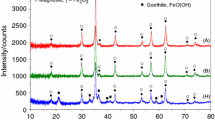Abstract
This paper presents a novel approach in synthesizing SiO2–Fe3O4 magnetic carrier with high stability. The Fe3O4 magnetic powders were synthesized via one-step method named carbon reduction method. The advantages of the methods are of simple process, none lead-in pollution agent, low cost and adaptation to large-lot production. The stability of the magnetic powders is improved through modifying the Fe3O4 with SiO2 in solation method. The results of the characterizations show that the superparamagnetic SiO2–Fe3O4 sub-microparticles (~600 nm) with saturation intensity of 36.4 mA·m2·g−1 are obtained successfully. Moreover, the quantitating, repeatability and high stability of the carbon reduction method are demonstrated as well.




Similar content being viewed by others
References
Salerno M, Diaspro A, Cingolani R, Athanassiou A. Magnetic force microscopy and energy loss imaging of superparamagnetic iron oxide nanoparticles. Sci Rep. 2011;202:1.
Pan T, Zhu J, Su H, Yang CF. Ni segregation and thermal stability of reversed austenite in a Fe–Ni alloy processed by QLT heat treatment. Rare Met. 2015;34(11):776.
He L, Tan YF, Wang XL, Jing QF, Hong X. Tribological properties of laser cladding TiB2 particles reinforced Ni-base alloy composite coatings on aluminum alloy. Rare Met. 2014;34(11):1.
El-Ton AM, Khan A, Labis JP, Ibrahim MA, Al-hoshan M. Synthesis of magnetic core–mesoporous silica shell nanoparticles using anionic surfactant and their application for ketoprofen control release. Chem Lett. 2012;41(10):1357.
Chen F, Xie S, Zhang J, Liu R. Synthesis of spherical Fe3O4 magnetic nanoparticles by co-precipitation in choline chloride/urea deep eutectic solvent. Mater Lett. 2013;112:177.
Wang C, Wei YJ, Jiang HY, Sun SH. Tug-of-war in nanoparticles: competitive growth of Au on Au–Fe3O4 nanoparticles. Nano Lett. 2009;9(12):4544.
Yang C, Wu J, Hou YL. Fe3O4 nanostructure: synthesis, growth mechanism, properties and applications. Chem Commun. 2011;47(18):5130.
Mira J, López-Pérez JA, López-Quintela MA, Rivas J. Magnetic iron oxide nanoparticles synthesized via microemulsions. Mater Sci Forum. 1996;235:297.
Zhou ZH, Wang J, Liu X, Chan HSO. Synthesis of Fe3O4 nanoparticles from emulsions. J Mater Chem. 2001;11(6):1704.
Massart R. Preparation of magnetite nanoparticles. IEEE Trans Magn. 1981;17(1):247.
Shen L, Laibinis PE, Hatton TA. Bilayer surfactant stabilized magnetic fluids. Synth Interact Interfaces Langmuir. 1999;15(2):447.
Fang LM, Zu XT, Li ZJ, Zhu S, Liu CM, Zhou WL, Wang LM. Synthesis and characteristics of Fe3+-doped SnO2 nanoparticles via sol–gel-calcination or sol–gel-hydrothermal route. J Alloys Compd. 2008;454(1):261.
Lee HS, Kim EH, Shao H, Kwak BK. Synthesis of SPIO-chitosan microspheres for MRI-detectable embolotherapy. J Magn Magn Mater. 2005;293(1):102.
Oliveira LC, Rios RV, Fabris JD, Garg V, Sapag K, Lago RM. Activated carbon/iron oxide magnetic composites for the adsorption of contaminants in water. Carbon. 2002;40(12):2177.
Vong MSW, Bazin N, Sermon PA. Chemical modification of silica gels. Sol–Gel Sci Technol. 1997;8(1–3):499.
Bumb A, Brechbiel MW, Choyke PL, Fugger L, Eggeman A, Prabhakaran D, Hutchinson J, Dobson PJ. Synthesis and characterization of ultra-small super paramagnetic iron oxide nanoparticles thinly coated with silica. Nanotechnology. 2008;19(33):335601.
Selvan S, Patra PK, Ang CY, Ying JY. Synthesis of silica-coated semiconductor and magnetic quantum dot sand their use in the imaging of live cells. Angew Chem. 2007;119(14):2500.
Xiang J, Lu W, Hu YJ, Wu Y, Yan H, Lieber CM. Ge/Si nanowire heterostructures as high-performance field-effect transistors. Nature. 2006;441(7092):489.
Yang RG, Chen G, Dresselhaus MS. Thermal conductivity modeling of core–shell and tubular nanowires. Nano Lett. 2005;5(6):1111.
Acknowledgments
This work was financially supported by the Natural Science Foundation of Science and Technology Agency of Shanxi Province, China (No. 2011011013-2).
Author information
Authors and Affiliations
Corresponding author
Rights and permissions
About this article
Cite this article
Zhang, Q., Gao, LB., Li, JY. et al. Synthesis of magnetic carrier sub-microparticles with high stability through carbon reduction and solation coating methods. Rare Met. 35, 870–873 (2016). https://doi.org/10.1007/s12598-015-0662-7
Received:
Revised:
Accepted:
Published:
Issue Date:
DOI: https://doi.org/10.1007/s12598-015-0662-7




